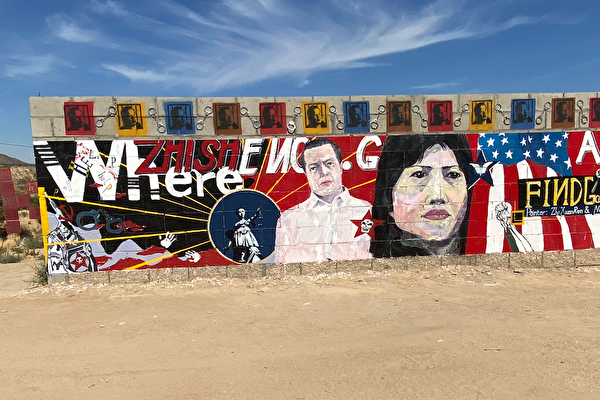“Turning decay into magic” is the mark of an exceptional artist. Simple materials like stones, wood, paint, and iron frames can be transformed into captivating works of art in the hands of an artist. In the Mojave Desert of Southern California, a group of artists have turned the desert into a base, a place to expose the communist tyranny, and to call for conscience, justice, and courage.
Yan Ne, a former art teacher from Guangxi, is one of these artists. After months of hard work under the scorching sun and in the yellow sands of the desert, he completed a mural titled “Chinese Conscience,” featuring human rights lawyer Gao Zhisheng. He described this work as a “benchmark” in his artistic career. He said, “It represents my determination to overthrow the Chinese Communist Party and marks a new beginning in my life.”
“Completing this piece is a lifelong dream come true for me,” Yan Ne said. “On this piece of land in the desert, there is once again a work of art that can voice out for the Chinese people.”
Many Chinese people did not plan to come to the United States before they left their homeland. Yan Ne was no exception. However, after his father came to the US in 2019, he found himself facing increasing political pressure from the Chinese Communist Party.
Raised in a Christian family with a long tradition of faith, Yan Ne’s ancestors had been Christians since his great-grandfather’s generation, with both his grandfather and uncle being pastors. Before the pandemic, his father was targeted by the CCP for spreading Christianity, causing frequent harassment by the police. His father was repeatedly summoned to the public security bureau for reprimand and restricted in his movements, with the entire family prohibited from attending local Christian gatherings.
“Since then, I have developed a strong resentment towards the CCP and realized the importance of freedom of speech and belief,” Yan Ne said. Influenced by his father, he joined a local underground church during his college years. However, because the church refused to register as a CCP-approved “Three-Self Church,” it was shut down by the authorities three times, and several elders and pastors were imprisoned.
“I feel that under the CCP’s dictatorship, the people see no hope and are pitiful like the walking dead,” Yan Ne expressed.
After his father came to the US and saw the Freedom Sculpture Park vandalized by the CCP and in need of help, Yan Ne stayed to assist sculptor Chen Weiming in the creation of sculptures such as the CCP Virus and Iron Chain Maiden, as well as artworks depicting the Hong Kong protests. When he contacted his father while still in mainland China, the state security became aware.
The state security asked him to go to the public security bureau, but he refused to go. Subsequently, the local public security bureau chief, accompanied by state security and cyber police, visited the guesthouse he managed, threatening him to cease contact with his father and to stop making public statements online. Otherwise, he would face fines and detention.
“This is very inhumane,” Yan Ne remarked. He found that the warnings from the CCP authorities were not just empty threats. He discovered he was being “artificially restricted” on the platform of his guesthouse by the authorities’ interference.
Concerned for his safety, Yan Ne followed his father’s footsteps and came to the US at the end of December 2023.
“The most challenging task I encountered in the desert was not sculpting, but creating the mural of Gao Zhisheng,” Yan Ne stated.
While the coastal areas of Los Angeles enjoy pleasant temperatures, the desert just over a hundred miles away presents a different scene: even in March and April, high temperatures are common during the day, and by May and June, scorching heat becomes frequent. He explained, “The desert is particularly hot. We can only start working very early in the day, as by 10 a.m., the heat becomes unbearable. We need to take breaks until 4 or 5 p.m. to continue working.”
Despite wearing hats and having towels to wipe away sweat, Yan Ne’s skin darkened from the sun exposure, leading people to mistakenly assume he was Filipino upon their first meeting.
At times, they needed to cut steel plates with tools. Even though they wore protective gear, sparks would still burn through gloves and socks, causing skin burns.
Although the creation process was tough, the friendships built amongst the volunteers through mutual support brought them joy and comfort. However, they also faced very difficult moments. Before the arrival of the June 4th anniversary and as the “Monument to the Victims of Communism” sculpture was nearing completion, several sculptures were deliberately damaged, and a large bucket of paint purchased by Yan Ne went missing. To finish the work, he had to spend over a thousand dollars to buy it again.
During the process of painting the mural of Gao Zhisheng, Yan Ne increasingly felt the significance of his work: “This painting not only questions where Gao Zhisheng is and seeks the missing Gao Zhisheng, but also aims to continue his call for justice and give voice to more victims and prisoners of conscience.”
One of the happiest moments for Yan Ne during this period was the increasing number of local residents and visiting tourists who brought them water and food, allowing them to work peacefully.
“The local people’s understanding of the CCP has ‘reached a new level’,” Yan Ne remarked. Some Americans, upon learning about their work, expressed their intention to vote to keep the government away from the CCP in the future.
“In the future, I will create more murals or sculptures to expose the evils of the Communist Party. I hope more people will learn about the wickedness of the CCP and its toxic influence on the world,” he concluded.

